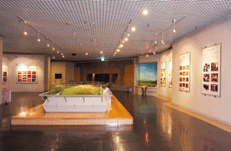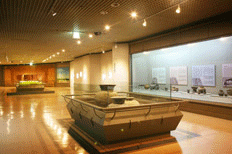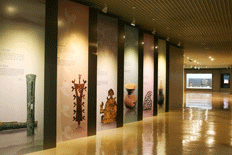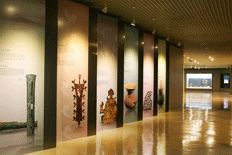
In the 1st Exhibition Hall are there are many types of tombs for each age and grave goods, through which we can see synthetically the history and transition process of Korean tombs from Neolithic Age to Three Kingdoms Age. In this hall, we can examine the characteristics both of the tombs in Busan area and of the ancient Gaya cultures. Further, we can see the achievement and meaning of the excavation of Bokcheondong Ancient Tombs that has been performed 8 times since 1969.

Though the careful treatment of a corpse by human beings existed in the Old Stone Age, the preparation of tomb and performance of burial ceremony in full scale began in Neolithic Age. The tombs in Neolithic Age seem to have small size and are simple in its kinds when compared with those in Bronze Age. The forms of tombs are Ummudeom(Dugout Mud Hut tomb), Dokneolmudeom(Stone Coffin Tomb), etc., and in a tomb are sometimes buried many kinds of living means like personal ornaments, earthenware, stoneware, etc.
When the Bronze Age came that focused on rice farming, different types of tombs were built in each area, including Dolneolmudeom(Stone Coffin Tomb), Ummudeom(Dugout Mud Hut tomb), Doldeotneolmudeom(Stone Coffin Tomb), Dokneolmudeom(Jar Coffin Tomb), etc. Especially, the megalithic monuments like Goindol(Dolmen) were built throughout the Korean Peninsula. As for the grave goods, bronze dagger, bronze ax, stone arrowhead, personal ornaments and other items were buried together with the corpse, through which we can see the social status of the deceased.

As the Iron Age Cultures were spread in full scale in Korean Peninsula, many kingdoms appeared in various parts of the country. In the northern part was settled by Buyeo, Goguryeo, Dongye, Okjeo, and in the south of the central part Mahan, Jinhan and Byeonhan of Samhan grew to Baekje, Silla and Gaya respectively. As political system appeared and ancient countries were established in the eras of Samhan and Three Kingdoms, different kinds of tombs were built in various forms and structures in each country and area. Especially, the social status of the buried was reflected in a tomb, and Gochong and Gobun were made, symbolizing a man with supreme power. In the first half of Samhan, small sized tombs were built with Neolmudeom as the center, and in the latter half, as the size of a tombs were getting larger, the Deotneolmudeom began to be prevalent, in which many remains could be buried with the corpse.
In the era of Three Kingdoms, different forms of tombs were built in each country, Dolmujimudeom(Stone mound tomb) and Byeokdolmudeom(Brick piled tomb) in Goguryeo and Baekje, Dolmujideotneolmudeom(Stone mound & wooden coffin tomb) and Gudeongsikdoldeotneolmudeom(Dugout mud hut type stone coffin tomb) in Silla and Gaya. In the era of Unified Silla, as the Buddhist culture developed, massive tombs disappeared, and the cremation type tomb began to be widely prevalent .

The ancient tombs in Busan area are heavily distributed in the Dongrae basin around Hwadong brook and Oncheon brook mainly with Suyeong river as the center, and other than this, small number of tombs are located in the entire area of Gwaejeong-dong, Danggam-dong and Noksan-dong. Dongrae area in ancient period grew to be a power equipped with active overseas trade and powerful military force based on iron. In the Dongrae Bokcheondong Ancient Tombs around the first half of 4th century, the size of tomb became larger and the oversized tombs with lots of relics buried with the dead body began to appear, reaching the peak around 5th century. On a cultural basis, while absorbing the cultures both of Silla and Geumgwangaya area, this area got to be tinged with independent color of its own.
However, after the latter half of the 5th century, as the power of Silla expanded to Yeongnam area, the Busan area began to be absorbed into the Silla cultures, losing its individuality of previous times.

Bokcheondong Ancient Tombs are typical remains of tomb in Three Kingdom period, which were built all over the hills spreading out to south from the Maan mountain in Dongrae. On top of the hills, large tombs are distributed, and in the slope and surrounding areas, middle and small sized tombs are distributed.
The ancient tombs were built from 2nd century to 7th century, gradually moving to the north from the south of the hills, and more than 12,000 pieces of remains were excavated, including 191 tombs, earthenware, ironware, etc. The Bokcheondong Ancient Tombs that had been excavated 8 times from 1969 to 2008 which gave an opportunity to reveal the ancient history and cultural identity of Busan which had remained unclear so far. They are very important relics to let us know the excellent ironware cultures of Gaya.

In the area of ancient Gaya, there were six(6) Gayas, which were ‘Geumgwan Gaya’ in Busan area, ‘Ara Gaya’ in Haman, ‘Daegaya’ in Goryeong, ‘Sogaya’ in Goseong, ‘Bihwagaya’ in Changnyeong, ‘Seongsangaya’ in Seongju.

In the Image Data Room, 6 kinds of videos related to the themes of ancient cultures of Korea are played, including ‘Gaya, the traces of its brilliant history’, ‘Ironware cultures in Three Kingdoms period’, ‘Armor and Harness’, ‘Personal ornaments in Three Kingdoms period’, ‘Earthenware cultures of Bokcheon-dong Ancient Tombs’, ‘Manufacturing process of earthenware’.